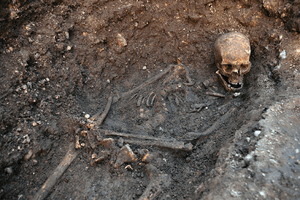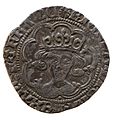Richard III of England facts for kids
Quick facts for kids Richard III |
|
|---|---|

Richard III King of England and France,
Lord of Ireland |
|
| King of England (more...) | |
| Reign | 26 June 1483 – 22 August 1485 (2 years, 57 days) |
| Coronation | 6 July 1483 |
| Predecessor | Edward V |
| Successor | Henry VII |
| Born | 2 October 1452 Fotheringhay Castle, Northamptonshire |
| Died | 22 August 1485 (aged 32) Bosworth Field, Leicestershire |
| Burial | Greyfriars (Franciscan Friary), Leicester |
| Consort | Anne Neville |
| Issue | Edward of Middleham, Prince of Wales |
| House | House of York |
| Father | Richard Plantagenet, Duke of York |
| Mother | Cecily Neville, Duchess of York |
Richard III (1452–1485) was an English king. He ruled England from 1483 to 1485. He was the last king from the House of Plantagenet.
Richard was part of the House of York during the Wars of the Roses. He was the younger brother of King Edward IV. When King Edward IV died, his 12-year-old son became King Edward V. Richard was made "Protector" to rule the country until Edward V grew up. However, Richard III took the throne for himself. Soon after, Edward V and his younger brother disappeared while living in the Tower of London.
Many people believed Richard had ordered the boys to be killed. Historians are still not sure about this. Many of his own supporters turned against him. He stopped a rebellion by his friend, the Duke of Buckingham. But then he faced another rebellion by Henry Tudor. This led to the Battle of Bosworth Field. Richard was killed in this battle, and his army lost. His body was quickly buried in a church in Leicester. In 2012, his body was found under a car park. He was reburied in Leicester Cathedral in 2015.
For many years, Richard III was seen as a bad guy. The Tudor kings and queens encouraged this idea. Shakespeare's famous play Richard III also showed him as evil. Some writers from his time saw him as a hero. Others saw him as a villain. Today, some say Richard III made good laws, even if he was ruthless. Others argue that being ruthless was common for powerful people back then.
Contents
Richard's Early Life
Richard was the youngest son of Richard, Duke of York. He had three older brothers: Edward, Edmund, and George. Richard's father and his brother Edmund were killed in battle during the Wars of the Roses. His oldest brother, Edward, was a skilled soldier. He won the throne of England from King Henry VI. Edward became King Edward IV of England. His brothers, George and Richard, became very powerful men.
Richard married Anne Neville. Her father had been a friend of Richard's family. Richard and Anne knew each other since they were children. Anne had been taken to France and married the Prince of Wales. He was the son of Henry VI. When the Prince of Wales died in battle, Anne became a widow. Soon after, she married Richard, even though he had been her first husband's enemy. Richard and Anne lived at Middleham Castle in North Yorkshire. They had one son, named Edward, after Richard's brother, the King. Richard often argued with his brother George. George was married to Anne's sister, Isabel. King Edward became so angry that he put George in prison, where he died.
King Edward married Elizabeth Woodville. She had been married before and had many relatives. Soon, her relatives became very rich and powerful. This made other important people unhappy. Edward and Elizabeth had several children. These included two sons, named Edward and Richard.
When King Edward IV suddenly died in April 1484, his older son became King Edward V. But he was still a young boy. Richard had been asked by his brother, the King, to look after the two boys. Richard worried that the new young king would not be able to rule well. He also worried that the Woodville family would control the young king and rule the country themselves.
Richard Becomes King
Richard took the throne from his nephew two months later. He claimed that Edward IV's marriage to Elizabeth Woodville was not proper. This meant Edward V could not be king. Parliament then passed a law agreeing with this. Richard was crowned as Richard III on July 3.
Richard sent Edward and his brother to live in the Tower of London. A few months later, the princes in the tower disappeared. They were never seen again. This became known as the mystery of the Princes in the Tower. At the time, many people believed King Richard had ordered someone to kill them. Many historians agree, but there is no way to be completely sure. Richard was not in London at the time. However, the boys were guarded by men loyal to him. As people started to believe Richard had ordered the boys killed, many turned against him. One was Richard's friend, the Duke of Buckingham. He started a rebellion, but it failed. Henry Tudor, a distant relative of the House of Lancaster, then became Richard's main enemy. He returned to England and gathered an army.
Richard and Henry's armies fought at the Battle of Bosworth Field in 1485. Henry won the battle and became the next King of England, Henry VII. Richard was killed in the battle. He was the last English king to die in battle. He suffered two head wounds that would have killed him quickly. After the battle, his body was taken to Leicester. He was buried in Greyfriars Church.
Finding and Reburying Richard's Body
Greyfriars church was later torn down. The site became part of a large house's garden. For about 200 years, a stone pillar marked the grave site. This pillar disappeared by 1844. Other buildings were added over the years. By 1944, the area around the grave was a car park. It was for the nearby council offices. For a while, people thought Richard's body had been thrown into the river. A sign by the Bow Bridge in Leicester tells this story, but it was not true.
In 2012, archaeologists started a project to find the body. On August 24, 2012, they began digging in the car park. They found a skeleton on the very first day. On September 12, they thought the skeleton might be Richard III's. On February 4, 2013, they announced they were sure it was him. They used DNA testing to confirm it. His skeleton showed he had been killed by two head wounds. This matched how writers from the 15th century said he died. It also showed that his body was damaged more after his death.
On March 26, 2015, Richard III's body was reburied. It now lies in a special tomb in Leicester Cathedral.
What Historians Think About Richard III
For many years, people have discussed if Richard III was a good or bad king. His reign lasted only two years. During this time, he was very popular in some parts of the country. This was especially true in northern England. However, enough people disliked him. This allowed his enemies to raise a large army against him. They defeated him in battle.
People often say that "history is written by the winners." After Henry VII won, Richard III was often shown as a villain in books and stories. For example, in Shakespeare's play Richard III, he is shown as completely evil. On the other hand, some writers from Richard's time made him a hero. They ignored his faults.
In 1605, William Camden wrote, "he lived wickedly, yet made good laws." Modern historians try to be fair when judging Richard III. For example, some historians have praised him for giving ordinary people more rights. However, many also think that he really did order the killing of the Princes in the Tower.
Among the laws Richard III made were:
- Removing limits on printing and selling books.
- Giving more rights to people accused of a crime.
- Laws to protect people from fraud when land was sold.
- Bans on other types of fraud.
- Changing the law from French into English.
He also created the Council of the North. For the next 150 years, this council helped solve problems in Northern England.
Images for kids
-
The ruins of the twelfth-century castle at Middleham in Wensleydale where Richard was raised
-
Contemporary illumination (Rous Roll, 1483) of Richard, his wife Anne Neville, and their son Edward
-
Stained glass depiction of Richard and Anne Neville in Cardiff Castle
-
Detail from the Rous Roll (1483) showing Richard with a sword in his right hand, a globus cruciger in his left, a white boar (his heraldic badge) at his feet, framed by the crests and helms of England, Ireland, Wales, Gascony-Guyenne, France and St. Edward the Confessor.
-
Former memorial ledger stone to Richard III in the choir of Leicester Cathedral, since replaced by his stone tomb (as illustrated further below)
-
Late 16th-century portrait, (oil on panel, National Portrait Gallery, London)
-
A statue of Richard III now outside Leicester Cathedral
-
Tomb of Richard III in Leicester Cathedral, with his motto Loyaulte me lie (loyalty binds me) at right
See also
 In Spanish: Ricardo III de Inglaterra para niños
In Spanish: Ricardo III de Inglaterra para niños












